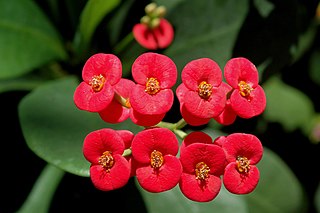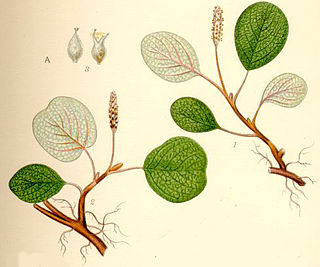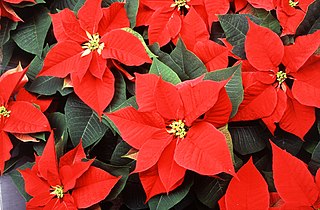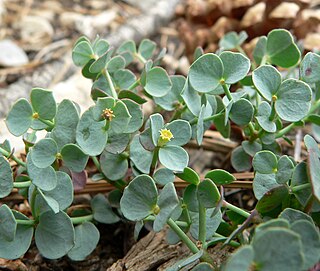
Euphorbia is a very large and diverse genus of flowering plants, commonly called spurge, in the family Euphorbiaceae. "Euphorbia" is sometimes used in ordinary English to collectively refer to all members of Euphorbiaceae, not just to members of the genus.

The poinsettia is a commercially important flowering plant species of the diverse spurge family Euphorbiaceae. Indigenous to Mexico and Central America, the poinsettia was first described by Europeans in 1834. It is particularly well known for its red and green foliage and is widely used in Christmas floral displays. It derives its common English name from Joel Roberts Poinsett, the first United States minister to Mexico, who is credited with introducing the plant to the US in the 1820s. Poinsettias are shrubs or small trees, with heights of 0.6 to 4 m. Though often stated to be highly toxic, the poinsettia is not dangerous to pets or children. Exposure to the plant, even consumption, most often results in no effect, though it can cause nausea, vomiting, or diarrhea.

In botany, a bract is a modified or specialized leaf, especially one associated with a reproductive structure such as a flower, inflorescence axis or cone scale. Bracts are usually different from foliage leaves. They may be smaller, larger, or of a different color, shape, or texture. Typically, they also look different from the parts of the flower, such as the petals or sepals. A plant having bracts is referred to as bracteate or bracteolate, while one that lacks them is referred to as ebracteate and ebracteolate, without bracts.

Heron Island is a coral cay located near the Tropic of Capricorn in the southern Great Barrier Reef, 80 kilometres north-east of Gladstone, Queensland, Australia, and 460 km (290 mi) north-north-west of the state capital Brisbane. The island is situated on the leeward (western) side of Heron Reef, a fringing platform reef of significant biodiversity, supporting around 900 of the 1,500 fish species and 72% of the coral species found on the Great Barrier Reef. During the summer months Heron Island is also home to over 200,000 birds including Noddy Terns and Mutton Birds.

Euphorbia heterophylla, also known under the common names of Mexican fireplant, painted euphorbia, Japanese poinsettia, paintedleaf, painted spurge and milkweed, is a plant belonging to the Euphorbiaceae or spurge family.

Aquilegia coerulea, the Colorado blue columbine, is a species of flowering plant in the buttercup family Ranunculaceae, native to the Rocky Mountains, USA. Aquilegia coerulea is the state flower of Colorado.

Gaillardia pulchella is a North American species of short-lived perennial or annual flowering plants in the sunflower family.

Chamaesyce is a genus of plants in the family Euphorbiaceae. Recent phylogenetic studies have shown that Chamaesyce is deeply nested within the broader Euphorbia. Specifically, Chamaesyce is very closely related to plants like Euphorbia pulcherrima, the popular poinsettia. Currently, all species have now been reclassified as species of Euphorbia. Specifically, this group now belongs to Euphorbia subgenus Chamaesyce section Anisophyllum. Taxonomically speaking, Chamaesyce is considered a synonym of Euphorbia.

Euphorbia antisyphilitica is a species of flowering plant in the spurge family Euphorbiaceae. It is native to the Trans-Pecos of Texas and southern New Mexico in the United States as well as Chihuahua, Coahuila, Hidalgo, and Querétaro in Mexico. Common names include candelilla and wax plant, but the latter is more often applied to members of the unrelated genus Hoya. It is shrubby and has densely clustered, erect, essentially leafless stems that are covered in wax to prevent transpiration.

Euphorbia milii, the crown of thorns, Christ plant, or Christ's thorn, is a species of flowering plant in the spurge family Euphorbiaceae, native to Madagascar. The species name commemorates Baron Milius, once Governor of Réunion, who introduced the species to France in 1821.

Salix reticulata, the net-leaved willow, or snow willow, is a dwarf willow, native to the colder parts of Europe, North America, and Northern Asia. It is found in the western United States, including the Sierra Nevada and Rocky Mountains. In Europe it extends south through the Carpathian Mountains and Alps to the Pyrenees and the mountains of Bulgaria and North Macedonia. It is common in Canada, Greenland and Finland, and present but rare in Scotland.

Euphorbia subg. Poinsettia is a subgenus deriving from the genus Euphorbia, and is endemic to North America. It contains around 24 species, of which the best known is E. pulcherrima, the poinsettia.

Euphorbia kuwaleana is a rare species of flowering plant in the euphorb family known by the common name kokomalei. It is endemic to Oahu, Hawaii, where it is known only from a four-kilometer stretch of the Waianae Range. Like other Hawaiian euphorbs, this plant is known locally as `akoko. It is a federally listed endangered species of the United States.

Lupinus lepidus, the Pacific lupine, prairie lupine or dwarf lupine is a perennial herbaceous plant in the pea family (Fabaceae) endemic to western North America. Many varieties have been described, several of which are considered separate species by some authorities.

Euphorbia flanaganii, commonly known as Transkei medusa's head, is a succulent plant that belongs to the family Euphorbiaceae. It is endemic to South Africa. Due to the breadth of the Euphorbiaceae, little research specific to E. flanaganii has been conducted.

Carex eburnea, known as ivory sedge, ebony sedge, and bristleleaf or bristle-leaved sedge, is a small and slender sedge native to North America, from Alaska and Newfoundland south to central Mexico.

Euphorbia davidii, known as David's spurge or toothed spurge, is a species of flowering plant in the spurge family Euphorbiaceae. It is an annual herb growing up to 2 feet tall. Leaves are opposite in arrangement with narrow to broadly elliptic blades.
Euphorbia discoidalis, commonly known as summer spurge, is a flowering plant. A dicot, it grows across parts of the southern United States. It reaches about 18 inches (460 mm) in height and has white flowers in the late summer and early fall. It is part of the Euphorbiaceae (spurge) family and the genus Euphorbia.

Euphorbia bicolor, commonly known as snow on the prairie, is a species of flowering plant in the genus Euphorbia, native to the southern United States. It grows 1-4 feet tall, has green and white alternate leaves, and is monoecious with unisexual flowers. It grows in hard clay soils of prairies, rangelands, and edges of forests.

Euphorbia brachycera is a species of flowering plant in the Euphorbiaceae family. It is referred to by the common name horned spurge and is native to Northern Mexico and the Rocky Mountains of the US. It is a rhizomatous herbaceous perennial growing in spreading mats, with narrow green leaves and yellow flowerheads. It can grow up to 2 feet tall. Some of its habitats include canyons, sandy or gravelly slopes, pine-oak woodlands, and mixed coniferous forest.



















